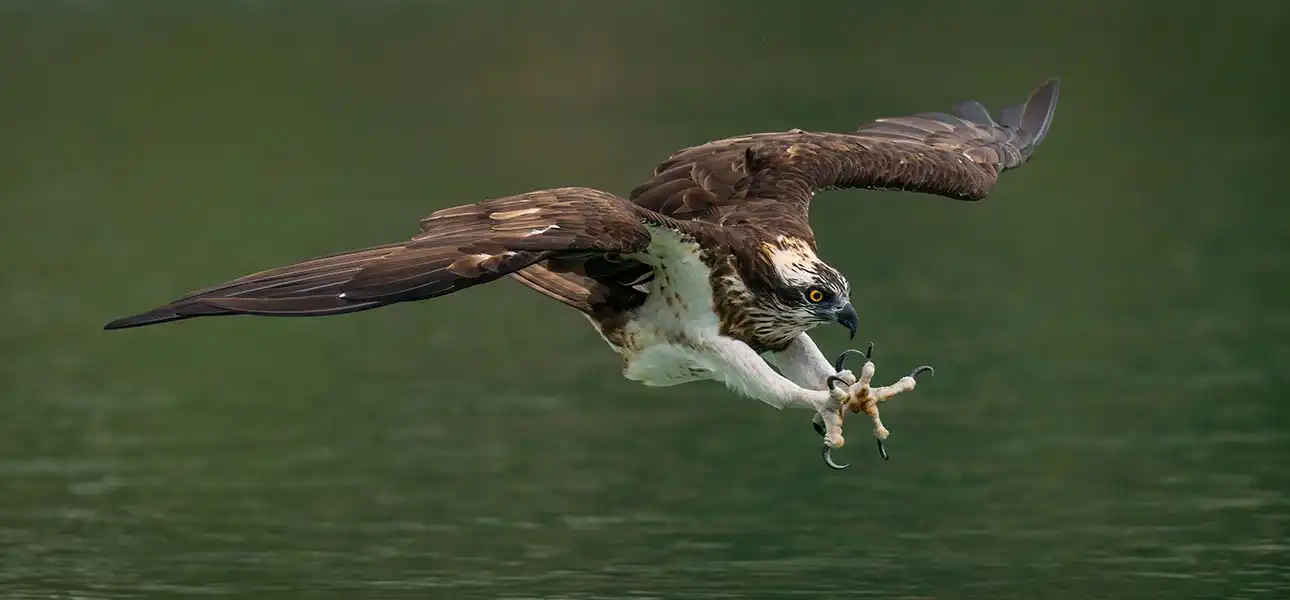
Considered as a rare bird in the UK, the Osprey is one of the most widely distributed birds of prey in the world. It is an unusual species, not closely related to any other bird of prey. Their toes are of equal length and (with the exception of owls) Osprey is the only raptor with a reversible hind toe, almost certainly an adaptation to its fish diet. Although world-wide in distribution, Australian Ospreys are now considered to form a second species, the Eastern Osprey.
Key Facts
Common name: Osprey
Scientific name: Pandion haliaetus
Habitat: Coastal areas as well as freshwater, but in the UK, they tend to be found near large lakes and nest in nearby trees.
Diet: Almost exclusively fish, but have been known to eat small mammals, amphibians, other birds and small reptiles.
Size: Average 56cm, wingspan 158cm. Females/males (1.5kg)
Status: Migrant breeding bird and passage visitor.
Population size: 240 pairs
Conservation status: AMBER (species whose population has declined historically but made a substantial recent recovery. Rare breeder in the UK).
Appearance
Ospreys are large birds, with long, narrow wings which can, when seen at height, be mistaken for a large gull! They are mostly brown above, and white below with a white head and distinctive brown stripe through the eye. They are invariably found near water, although in spring and autumn migrating Ospreys can be seen anywhere, whether dropping in to fish, or passing overhead.
Lifespan
An average in the wild of 9 years. Adults have an 85% year-to-year survival rate. Roughly 60% of juveniles will survive their first year. The oldest known wild bird was almost 21 years old (ringing recovery).
Nesting
Ospreys will not attempt to breed until their third year. Large, and often messy, twig nests are built in tall structures, usually trees, but increasingly on provided nesting platforms. A single brood consisting of 2-3 eggs is laid and incubated mostly by the female.
Number of eggs: 2-3
Incubation: 37 days
Fledging time: 53 days
Young birds must learn to hunt quickly before beginning their first migration south. Birds make their way leisurely south, stopping to hunt and becoming familiar with the areas through which they are passing. On return spring migration, due to the desire to return to territories, and not lose out to rivals, the migration is undertaken much more speedily.
Habitat and Distribution
Around the world, Ospreys are found wherever there is enough water to support their requirement for large fish. They can be found in coastal areas as well as freshwater, but in UK they tend to be found near large lakes, and they nest in nearby trees. They are still very much Scottish birds, although a number of pairs now breed in North Wales and there is a well-known colony at Rutland Water in the Midlands. Additional re-introduction attempts are being made at a variety of locations. A pair have more recently been seen at Ranworth Broad in the heart of the Norfolk Broads. Osprey has a cosmopolitan distribution, being found of every continent except Antarctica.
Ospreys formerly inhabited much of Britain, but heavy persecution brought about its demise with the species becoming extinct as a breeding bird in England in 1840, and from Scotland in 1916 (although there may have been occasional breeding attempts afterwards). In 1954 Scandinavian birds, which migrate through the UK, re-colonised Scotland naturally although this re-colonisation was very slow because of contamination of the food chain by organochlorine pesticides and the activities of egg collectors. By 1976 the breeding population was still only 14 pairs. Intensive nest protection helped the species to increase its toehold, and the numbers continue to increase, with several well-publicised re-introduction programmes adding to the total.
Movements
Highly migratory, British Ospreys winter in Africa and there is much dispersal of birds from their natal sites. Scandinavian breeding birds also pass through the UK on their way south, and it is from these birds that Osprey naturally recolonised the country.
Feeding
As their old name of ‘Fish Hawk’ testifies, fish is the main food of Osprey. The fish are usually grabbed from below the water surface, in a spectacular talon down, wing up strike by a hunting bird. Coarsely scaled feet help the Osprey to keep hold of its slippery prey, but birds often struggle to get airborne once more. They are able to gain height even whilst only flapping their wings above horizontal, to prevent them from getting too wet. Prey is transported in the talons in flight; large items, such as large trout, will be moved in the feet to lie head towards direction of travel, to reduce wind resistance. Most fish taken will weigh between 150–300g and be about 25–35 cm in length, although fish up to 2kg can be tackled.
Although 99% of their diet consists of fish occasionally, Ospreys may prey on small mammals, amphibians, other birds and small reptiles.

